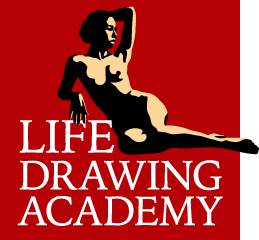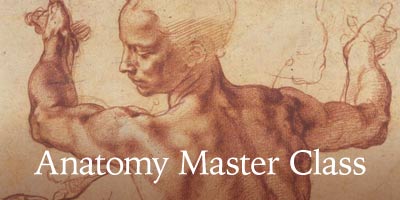Video by Vladimir London, a Life Drawing Academy tutor
Enroll in the Life Drawing Academy now!
How to Intersect Two Planes
Video lesson by Vladimir London, a Life Drawing Academy tutor
Before we begin with the topic of intersecting flat planes, I will flip through pages of my sketchbooks, showing you some sketches of intersected objects, such as pyramids, cylinders, cones and other geometric bodies. These sketches were done as a demonstration for students, who take the Life Drawing Academy Correspondence Course. In this course, students receive unlimited personal tutoring and learn all they need to know about constructive drawing. Because every student gets a custom designed drawing curriculum, it can include special tasks on intersection of objects. This subject is very much needed if you want to learn technical or architectural drawing, industrial design or simply interested in making creative compositions from imagination that involve a deeper knowledge of linear and aerial perspective, the theory of contours, and constructive drawing. There is nothing difficult about making such sketches when you know the rules of intersection and how to draw in perspective. In a series of videos, I will show you how to intersect flat planes, curved surfaces, and various objects with each other. This knowledge will help you to improve your three-dimensional thinking and fully express your creativity. Knowing how to intersect objects is not just about technical or architectural drawing. Above all, this know-how will give you better drawing skills and help in drawing whatever you see or imagine, including portraits and human bodies. Figurative drawing is based on constructive drawing principles. It is an important part of good drawing skills together with perspective, anatomy for artists, sequential steps of drawing portraits and figures. I hope you will find this series of constructive videos helpful.
Intersecting flat planes in perspective is one of the most fundamental topics in constructive drawing. Let's begin with the simplest case. Two flat rectangles with different heights stand on the same ground. I will outline these rectangles in darker lines. We draw all objects as if they are transparent. The footprints of these rectangles cross each other in one point. I marked this point as a small red circle. The intersection line goes from this point vertically because these planes are vertical. I will shade one plane, so you could better see this intersection geometry. I hope this example was simple to understand.
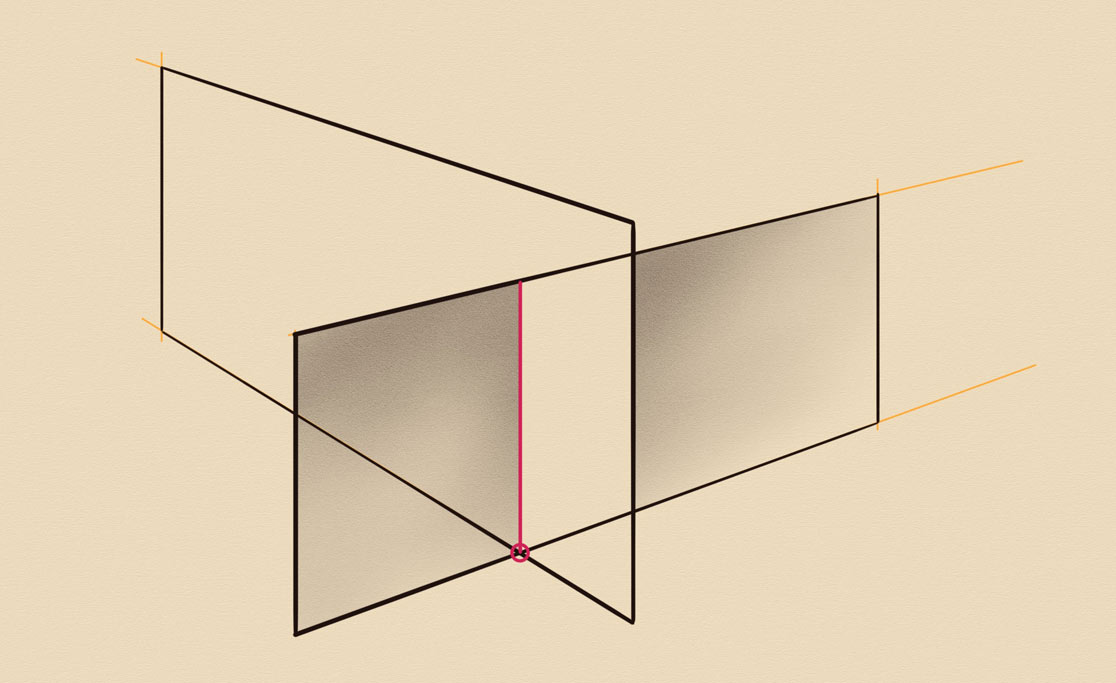
In the next example, I will demonstrate how to intersect two planes, one vertical and one tilted that are standing on the same ground and have parallel footprints. When drawing a tilted plane, it is very helpful to depict the projection of that rectangle on the ground. This geometry looks like a triangular prism. I will outline these two planes in darker lines. The red dot on the ground indicates where the projection of the tilted edge crosses the footprint of the vertical plane. From this point, we can draw a vertical line till it crosses with the tilted plane edge. I mark that cross-point in red. The cross-line between two planes is horizontal because their footprints are parallel. I marked this intersection line in red. Note where this line ends - at the left edge of the vertical rectangle. I will now shade this plane to illustrate how the tilted rectangle crosses it. I hope this example was also easy enough to follow.
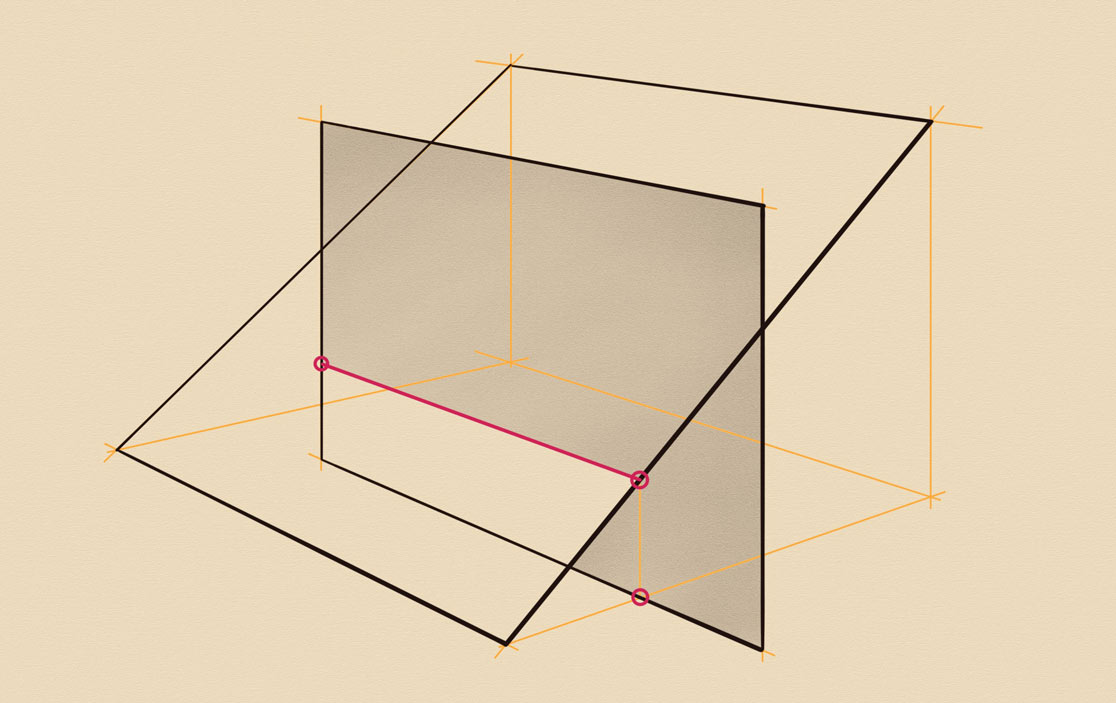
I will now make another drawing with two planes. One plane would be vertical and another tilted. These two rectangles are standing on the same ground and their footprints are perpendicular to each other. This is important to know because I can draw the projection from the tilted plane to that ground and see where this projection would intersect the footprint of the standing rectangle. This geometry helps to plot the intersection line between two planes. I will now outline these planes in darker lines. Note how I use the aerial perspective, making lines that are closer to a viewer bolder. The footprints of these two planes cross each other in the red dot. The green dots are used to plot the intersection lines, which I will mark in red. To differentiate two planes, I will shade one surface. This example is a bit more complicated than the previous one, but I hope you follow the logic.
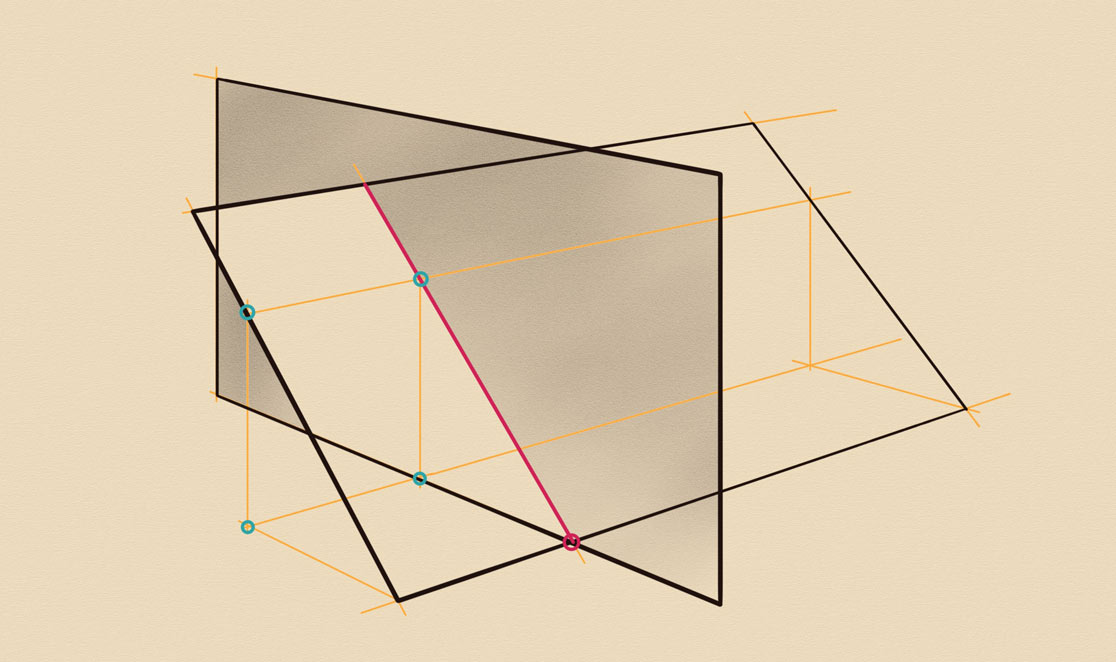
Let's make one more drawing with vertical and tilted planes standing on the same ground. This time, their footprints will cross each other at some oblique angle. The tilted plane is presented as a triangular prism with their projection to the ground. The vertical rectangle intersects this footprint. I will outline two planes in dark lines. Check out how I use the aerial perspective to suggest which parts of these objects are closer to a viewer by varying boldness of lines. Two footprints of planes cross each other in the red dot. The projection of the tilted plane edge also crosses the vertical rectangle footprint in another red dot. From this point, I can draw a vertical virtual line upward till it crosses the tilted edge. This point is also marked in red. I connect two red dots with the intersection line. This line is marked in red. I will shade the vertical plane to show this intersection. This is also a very simple case that I hope was easy to follow.
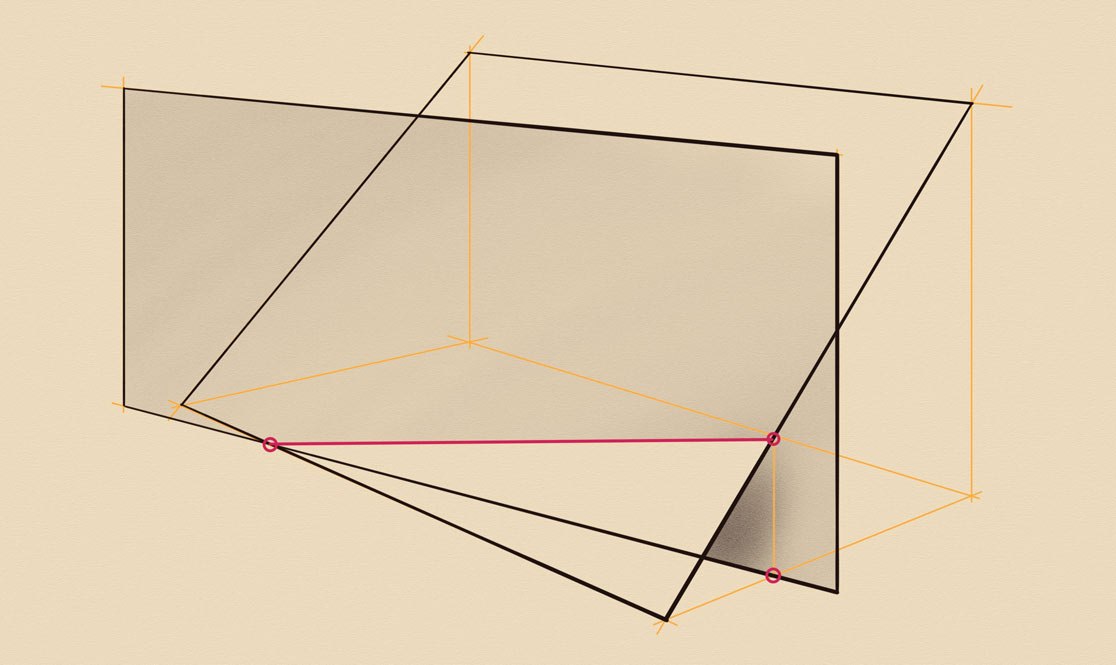
I will make another drawing. This time, two planes, one vertical and one tilted, will have footprints on the same ground at some oblique angle to each other. I will outline these rectangles in darker lines, following the rule of aerial perspective. As you can see, the footprints, which are lines where rectangles touch the ground, do not cross. However, the projection of the tilted plane to the ground crosses the vertical plane footprint in two points. I marked these dots in red. Two vertical lines can be plotted upward from these points. These virtual helping lines in yellow cross the top and side edges of the tilted plane. I mark the cross-points in red. Now, these two red points can be connected with the intersection line, which is also outlined in red. I will shade the vertical plane to demonstrate the intersection.

I will now make a bit more complicated drawing where two planes, one vertical and one tilted, intersect each other, but their footprints do not cross. These rectangles are also standing on the same ground. The tilted plane together with its projection on the ground appear as a triangular prism. I will outline these two rectangles in darker lines following the aerial perspective rule. As you can see, two footprints, which are lines where rectangles touch the ground, are at some oblique angle, but they do not cross each other. However, the projection of the tilted plane edge crosses the vertical plane footprint. I mark this cross-point in red. Another dot can be found where the projection of the tilted plane edge crosses the extension of the vertical plane footprint. I also mark that dot in red. From the first dot, I can now draw a vertical line till it crosses the tilted plane edge. From another red dot, we also draw a similar virtual line. The places where these lines cross the tilted edges are marked in small red circles. A virtual helping line can be connected from one point to another. I drew this line in yellow because it is a helping line so far. This yellow line crosses the vertical rectangle top edge as well as its right side edge. Two cross-points are indicated as red dots. The intersection line spreads between these two red dots. It is also marked in red. All that is left is to shade the vertical plane to illustrate the intersection.
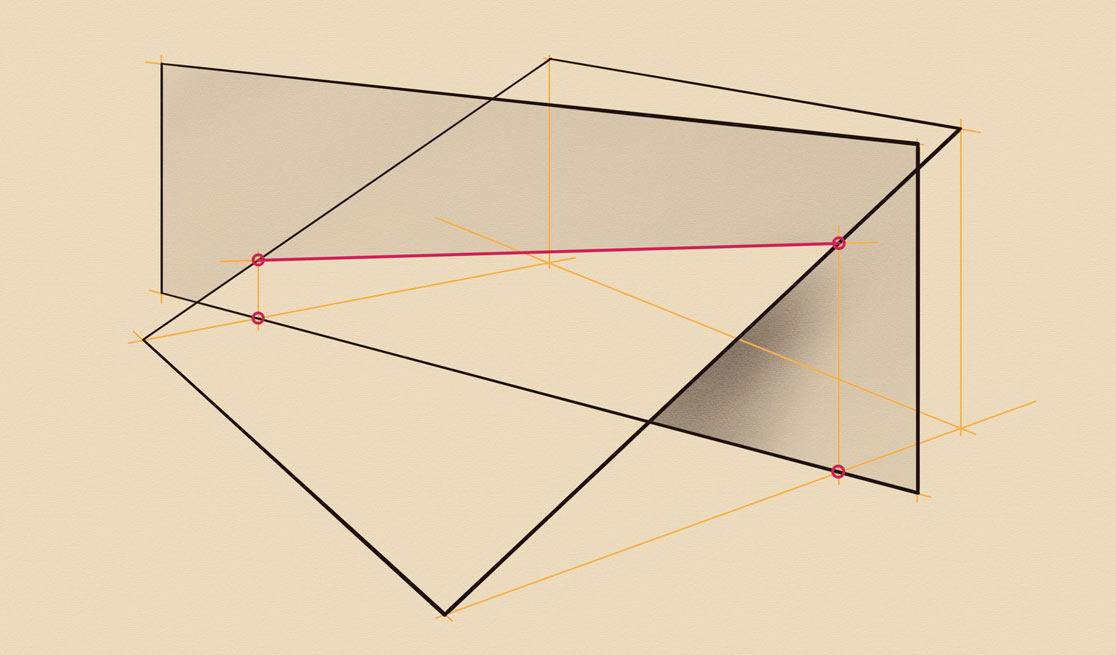
Let's make one more drawing of intersecting planes. One plane will be tilted and another vertical. They stand on the same ground, but their footprints do not cross each other; they are located at some oblique angle. The tilted plane is depicted as a part of the triangular prism. I will outline two planes in darker lines. The projection of the tilted plane edges crosses the vertical plane footprint in two points. I indicated these dots in red. From these points, we can draw two vertical helping lines till they cross the side edges of the tilted rectangle. These cross-points are highlighted in red. The intersection line spans between these two red dots. To reveal this intersection, I will shade the vertical rectangle.
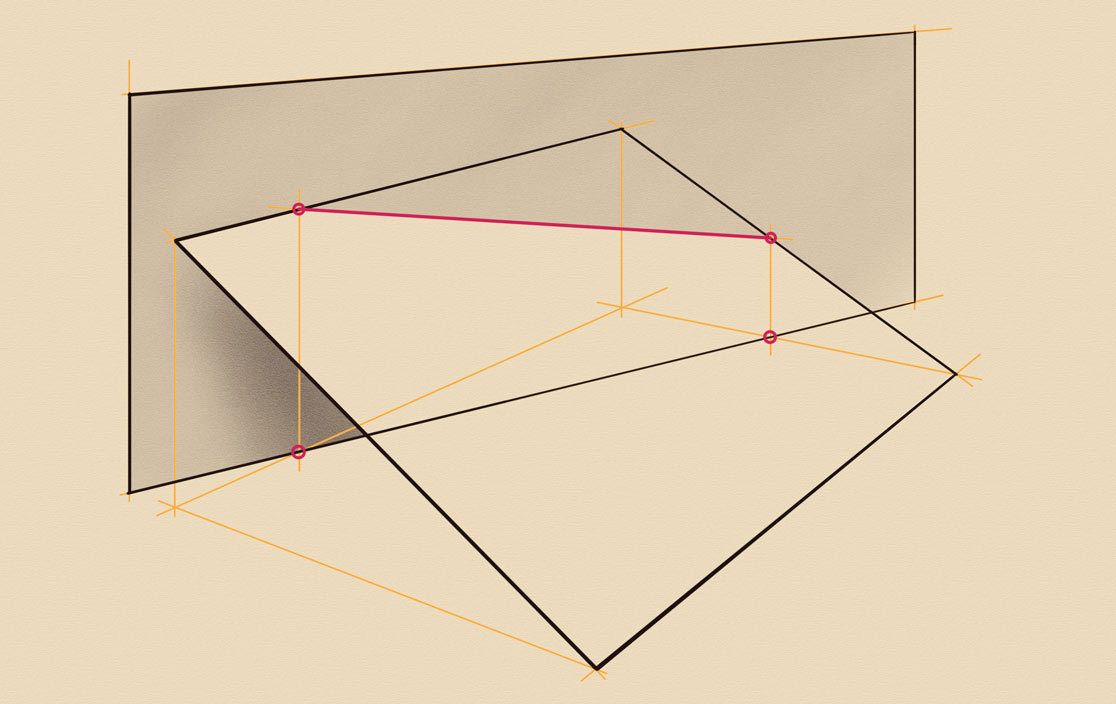
In all previous examples, two planes were standing on the same ground, but how about the cases when one plane is lifted above the ground? In this drawing, I will demonstrate how to intersect two vertical planes when their footprints are located on different levels. Let's draw a very simple case with two vertical rectangles. One rectangle levitates above the ground and its level is indicated by a virtual yellow line. I will outline planes in darker lines, making sure that their boldness varies according to the aerial perspective. The projection of the levitating rectangle edge to the ground is indicated as a red dot. From this dot, we can draw the projection of that plane to the ground. This yellow line crosses another rectangle footprint and the cross-point is indicated in red. From that point, I can draw a virtual yellow line upward. It crosses the lower rectangle in two red points. The line between these points is the intersection line. I mark it in red. To show this intersection geometry, I will shade one plane. This is a very simple case with two vertical planes.
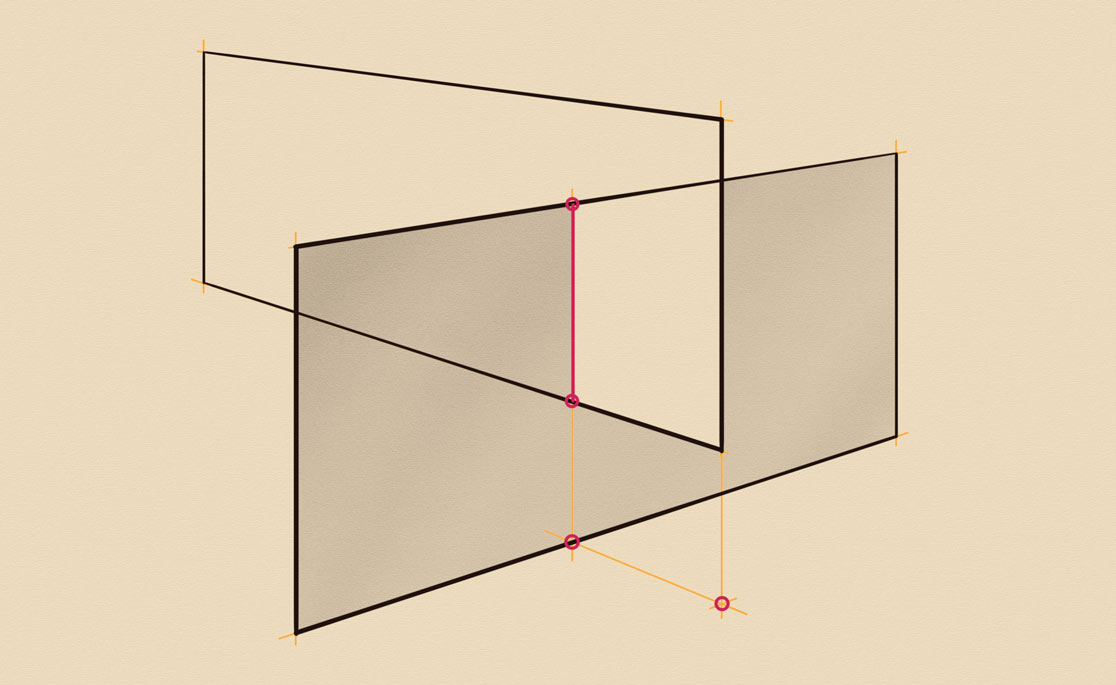
But what if one plane is horizontal? Let's see how to intersect a vertical plane with a horizontal rectangle. The horizontal plane is elevated above the ground. Its level is indicated by a virtual yellow line. I will outline two planes in darker lines following the aerial perspective rule. The projection of the horizontal rectangle corner to the ground is marked as a red dot. From that point, I can draw a virtual line in perspective that is a projection of the rectangle edge. It crosses the vertical plane footprint in red dot. From that dot, I can draw a virtual vertical line, which crosses the horizontal rectangle edge. The cross-point is highlighted in red. From that point, I draw the intersection line in perspective, which converges into the vanishing point on the left-hand side. This intersection line is marked in red here. Now, I can shade the vertical plane to reveal the intersection.

In the next drawing, I will show how to intersect two planes, one vertical and one horizontal, when their edges are located at some oblique angle. Once again, the horizontal rectangle is elevated above the ground. Its elevation is indicated by the helping yellow line. I will outline two planes in darker lines. The projection of the horizontal rectangle corner to the ground is marked as a small red dot. From that dot, I draw a helping line in perspective till it crosses the vertical plane footprint. The cross-point is indicated in red. From that point, goes a virtual vertical line and it crosses the horizontal rectangle edge in another red point. From that point, I can draw another vanishing line that follows the perspective vertical plane. Note, that these two rectangles are both depicted in a two-point perspective, but each plane has different vanishing points somewhere on the horizon level beyond the drawing area. How to draw in perspective is explained in depth in a separate video lesson: "How to Draw in Perspective - Comprehensive Course". The intersection line spreads between two cross-points. It is marked in red. I will shade the vertical rectangle to better illustrate this intersection.
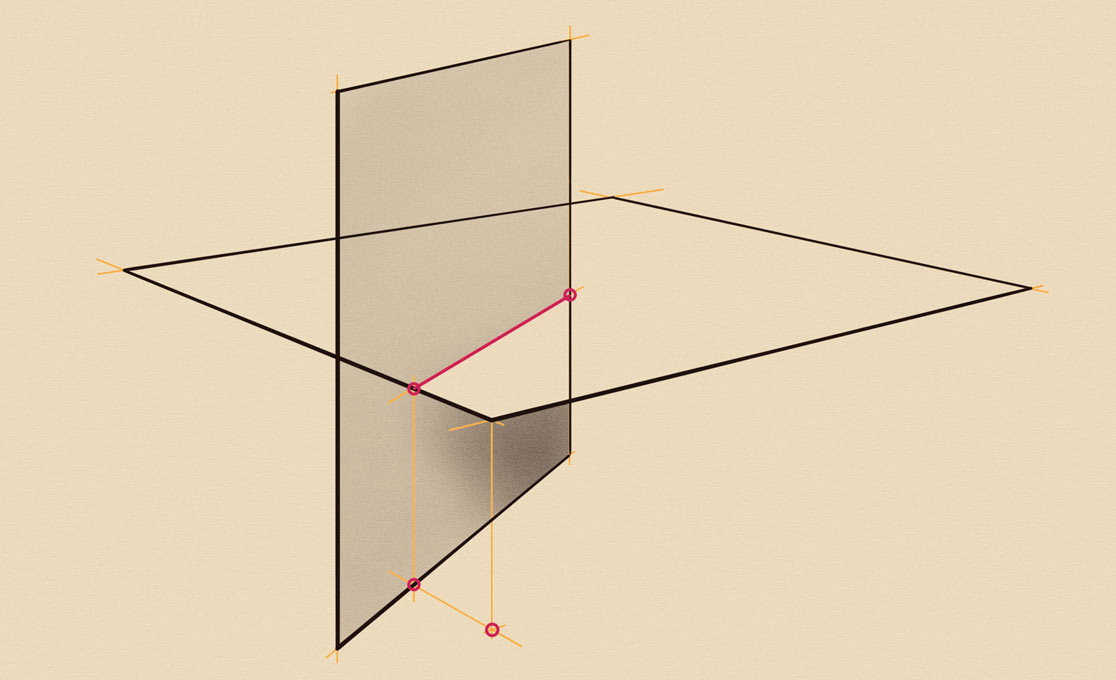
Let's examine a bit more complicated case - how to intersect a tilted plane with the elevated vertical rectangle. The Tilted rectangle is depicted as a part of the triangular prism. The elevation of the vertical plane is shown by the helping yellow line. I will outline these two rectangles in darker lines, following the aerial perspective rule by varying the boldness. The projection of the vertical rectangle side edge to the ground is marked as a red dot. From that dot, I draw the plane's projection in a yellow line. This line converges into some vanishing point beyond the drawing area. It crosses the tilted plane foot print in red point. It also crosses the virtual projection line in another red point. From these two red points, I can draw two vertical helping lines til they cross the tilted plane edges in two points. These points are highlighted in red. Between these dots, goes the intersection line, which is marked in red here. All that is left is to shade the vertical plane to better demonstrate this intersection.
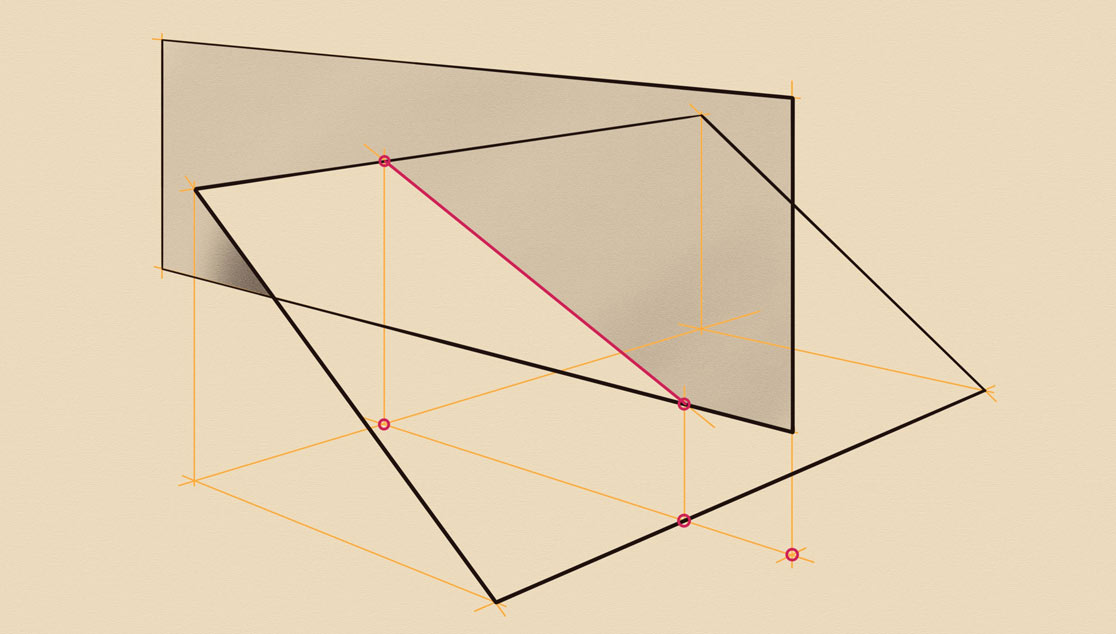
I will now show how to intersect a tilted plane by a vertical elevated rectangle. The edges of these rectangles are parallel to each other and therefore these rectangles are depicted in the same perspective. The elevation of the vertical plane is indicated by a virtual vertical line. I will outline both rectangles in darker lines. The point where the vertical rectangle edge projects to the ground is indicated by a red dot. From that dot, goes a virtual line in perspective. It crosses the projection of the tilted plane edge in a red point. From that point, I can draw a vertical helping line that crosses the tilted plane edge. The cross–point is marked in red. From that point, another virtual line in perspective goes horizontally and crosses the vertical rectangle edge as well the side of the tilted plane. I indicate these points in red. Between these points goes the intersection line, which is also drawn in red. I will shade the vertical rectangle to demonstrate this intersection.
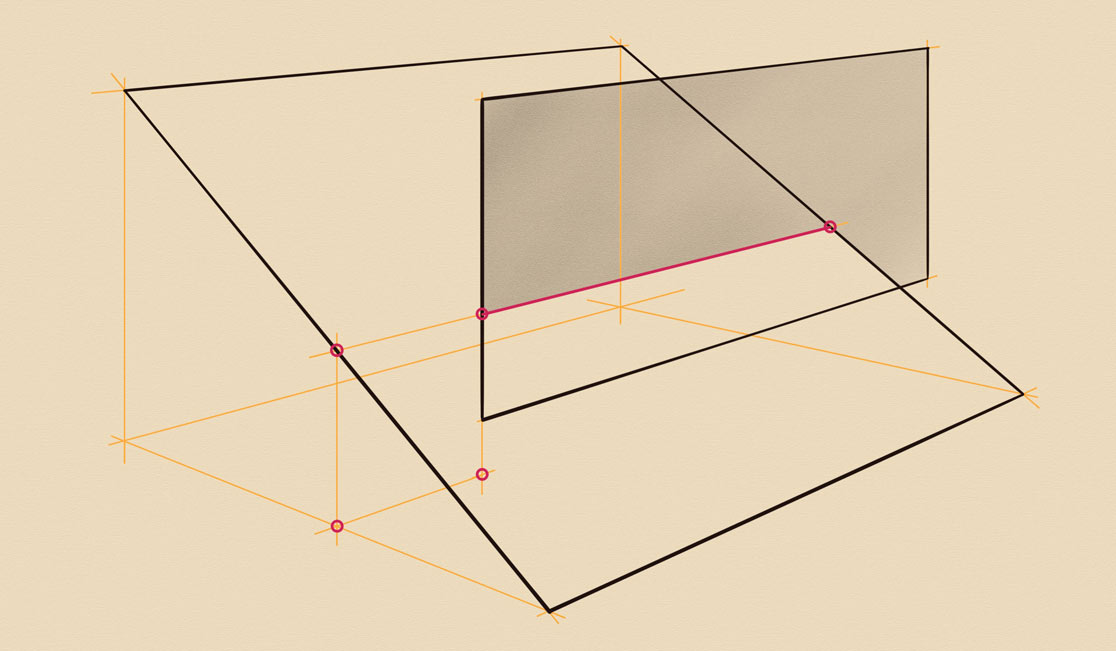
I will show you one more example of intersecting a tilted plane with an elevated vertical plane. These planes do not have parallel edges. It is better to draw a tilted plane as a part of the triangular prism. The vertical plane is raised above the ground. The gap between this plane and the ground is shown as a vertical virtual line in yellow. The projection of the vertical rectangle edge to the ground is marked as a red dot. From that dot, I can draw a line in perspective, which is the projection of the vertical rectangle to the ground. This virtual line crosses the tilted plane projection in red dot. From that dot, I draw a vertical helping line, which crosses the tilted plane edge in a red point. By extending the projection line to the right, we get another cross-point marked here in red. Once again, a vertical line from that point gives one more cross-point on the tilted plane edge. This plane has two red cross-point, which can be connected with one line. This is the intersection line, it is marked in red. I will shade the vertical plane to demonstrate this intersection.

In the next drawing, I will show you how to intersect a tilted plane with the horizontal rectangle that is raised above the ground. Edges of these two planes will be parallel to each other. The tilted rectangle is depicted as the top side of the triangular prism. The footprint of this virtual prism is the projection of its top side to the ground. The level at which the horizontal plane is raised above the ground is indicated by a helping yellow line. The projection of the corner of this rectangle to the ground is marked as a red dot. From that dot, I plot a virtual line on the ground. It follows the same perspective and points to the vanishing point, which is located beyond the drawing area. This line crosses the projection of the tilted plane edge in red point. From that point, I draw a helping vertical line till it crosses the horizontal plane edge. This cross-point is indicated in red. Another helping line that goes horizontally in perspective gives one more cross-point on the tilted plane edge. This red point is used to plot a perpendicular horizontal line that is the intersection line. I mark this intersection in red. To reveal the geometry of this intersection, I will shade the tilted plane. As you can see, the principle of finding intersection of two planes with parallel edges is not that complicated.
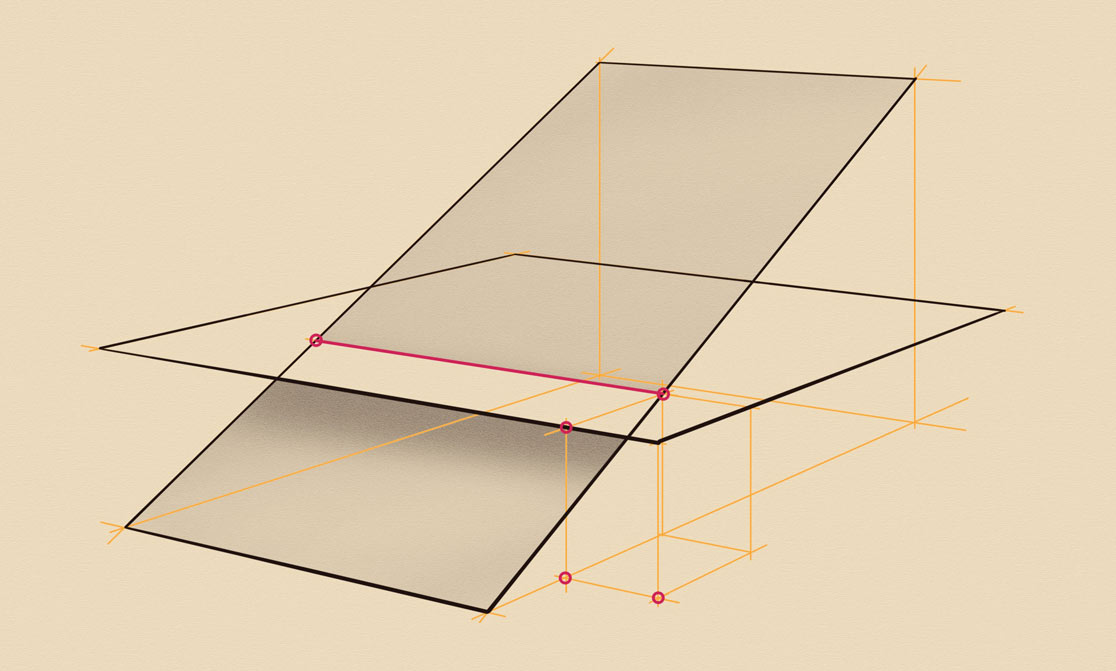
I will now explain a bit more challenging case, when the edges of tilted and horizontal planes are not parallel. The tilted plane is presented as the top side of a virtual triangular prism. The horizontal plane is raised above the ground. The distance between this plane and the ground is presented as a vertical virtual line. I will outline these planes in a darker color, following the rule of aerial perspective. Those parts that are closer to a viewer are bolder than those that are further away. The projection on the ground of the horizontal rectangle's corner is marked as a red dot. From that point, I draw a line horizontally because this plane is depicted in a one-point perspective. This virtual projection line crosses the tilted plane footprint in the red dot. From that dot, I draw a vertical line. It crosses the horizontal plane edge in a red dot. Also, from the footprint, I draw a tilted line that goes along the tilted plane surface. The next virtual line goes in perspective along the horizontal plane and crosses the previous line. Through the cross-point that belongs to both horizontal and tilted planes, I can now draw a horizontal line in perspective, which is the intersection line. I mark it in red. This line spreads between the tilted plane edge and the horizontal rectangle edge. All that is left is to shade the tilted plane to reveal the intersection geometry.
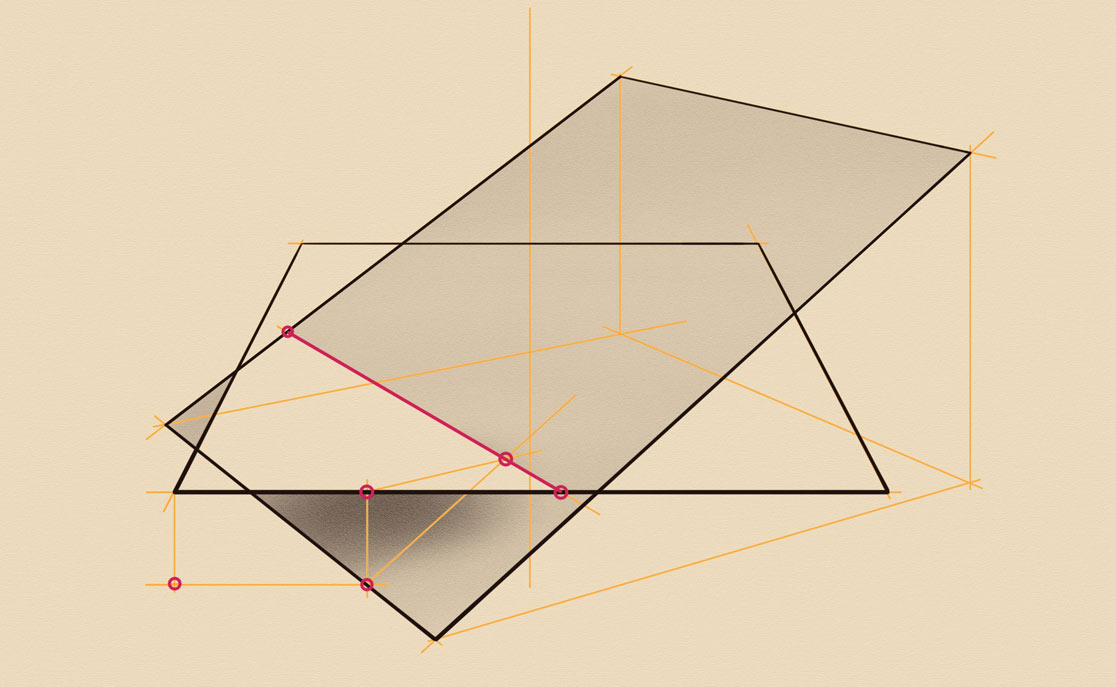
In the next drawing, I will show a bit more interesting case when both planes are tilted. These planes will be presented as top sides of triangular prisms. The footprints of these prisms have parallel sides. The footprints of the planes cross each other in the red dot. Another red dot shows where projections of side edges cross. From that point, I draw a vertical helping line till the tilted plane edge. Now, I can connect two red dots with the intersection line.
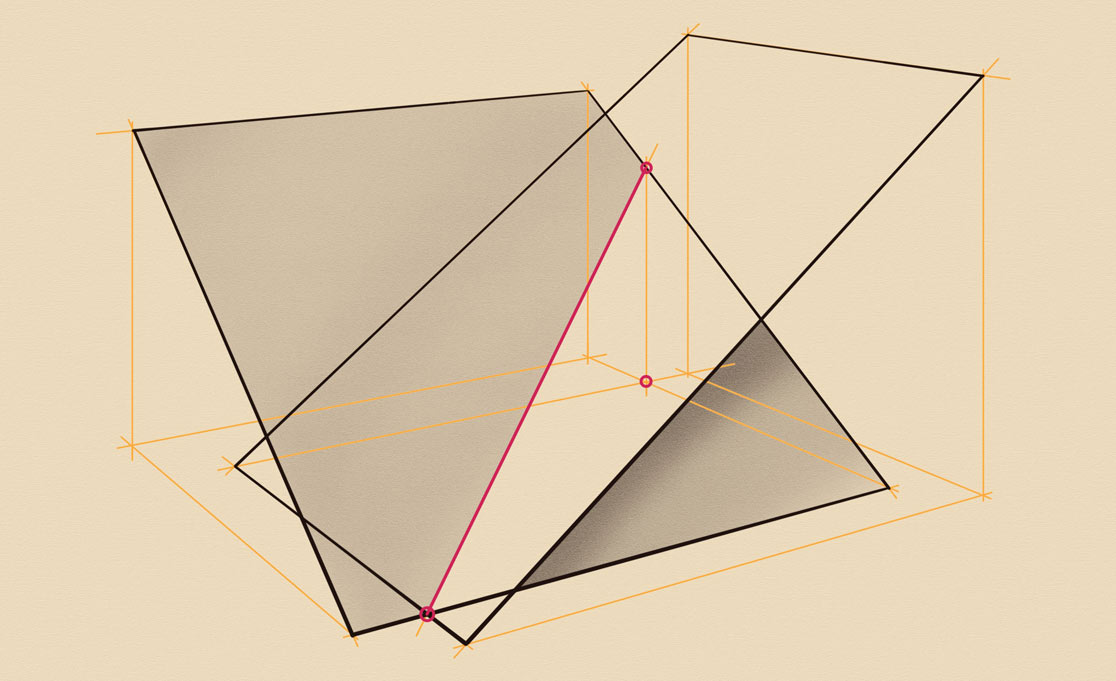
We can make the previous example with two tilted planes a bit more challenging. This time, one plane will be raised above the ground. From the projected point, I draw a virtual line in perspective that crosses the plane's footprint on the ground. From that point, I draw a tilted line that belongs to the tilted plane surface. It crosses the raised plane edge in red dot. From another corner, I draw one more line, which represents the tilted edge projection to the ground. One more red dot is used to plot the red point that belongs to both planes. The intersection line is between these two dots.
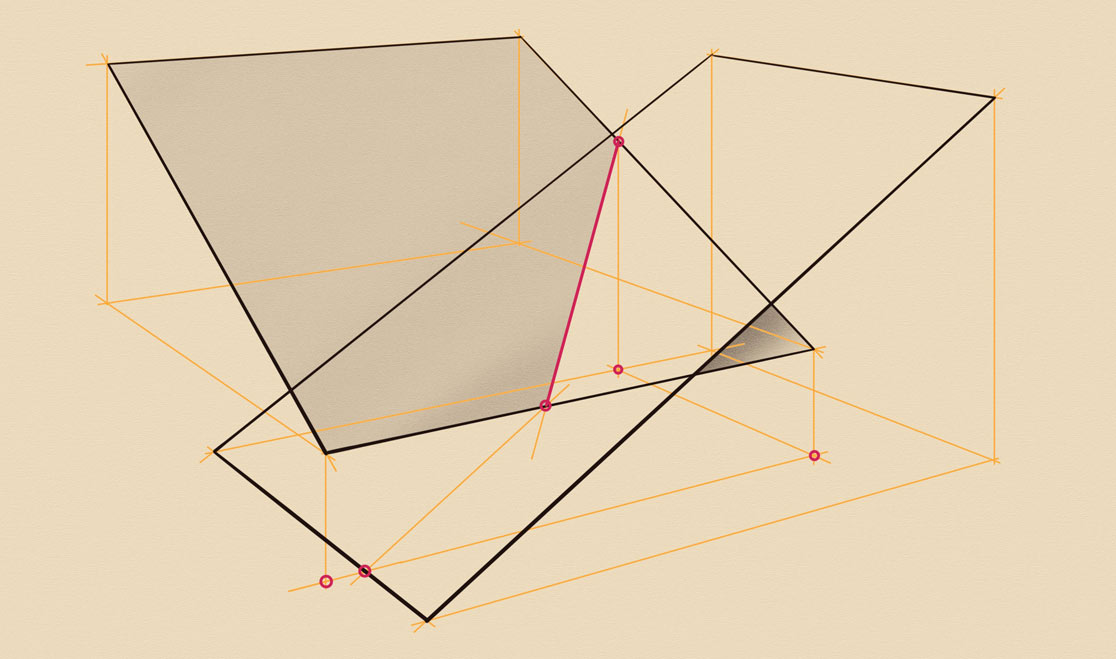
I hope that you found this lesson interesting and helpful. In the next videos, I will continue the topic of how to intersect different planes, curved surfaces and objects.
To learn more about constructive drawing and achieve the advanced level of drawing skills, take the Life Drawing Academy personal tutoring course.
To learn good drawing techniques, enroll in the Life Drawing Academy course:
Online Course
A self-study, self-paced course for you to learn fundamental methods of classical drawing and improve life drawing skills by watching video lessons and doing assignments
- Unlimited access to 52 life drawing video lessons
- Lifetime membership without deadlines
- Unlimited support from the Academy tutors
- Constructive critique of your artworks
- Member access to the Academy's Art community
- Place in the Academy's Students Gallery
- Exclusive members-only newsletter and bonuses
- Life Drawing Academy Diploma of Excellence in your name
One-time payment - Lifetime membership
$297 USD
Personal Tutoring Online + Online Course
The ultimate choice if you who would like to receive personal, one-to-one tutoring from the Academy teachers, which is custom-tailored to your skills and needs
- Everything in Online Course, plus:
- Dedicated team of art tutors
- Assessment of your current level of drawing skills
- Personalized curriculum tailored to your skills and goals
- Up to 100 drawing tasks with by-task assessment
- Unlimited one-to-one personal coaching with detailed per-task instructions and feedback
- Artwork critiques and results-oriented guidance
One-time payment - Lifetime membership
$997 USD
